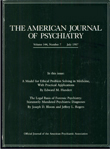Full and partial posttraumatic stress disorder: findings from a community survey
Abstract
OBJECTIVE: Full and partial posttraumatic stress disorder (PTSD) following trauma exposure were examined in a community sample in order to determine their prevalence and their relative importance and functional significance. METHOD: A standardized telephone interview with a series of trauma probes and a DSM-IV PTSD checklist was administered to a random sample of 1,002 persons in a midsized Midwestern Canadian city. The authors determined current (i.e., 1- months) prevalence rates of full PTSD, i.e., all DSM-IV criteria, and partial PTSD, i.e., fewer than the required number of DSM-IV criterion C symptoms (avoidance/numbing) or criterion D symptoms (increased arousal). Additional questions about interference with functioning were also posed. RESULTS: The estimated prevalence of full PTSD was 2.7% for women and 1.2% for men. The prevalence of partial PTSD was 3.4% for women and 0.3% for men. Interference with work or school was significantly more pronounced in persons with full PTSD than in those with only partial symptoms, although the latter were significantly more occupationally impaired than traumatized persons without PTSD. CONCLUSIONS: These findings in an epidemiologic sample underscore observations from patient and military groups that many traumatized persons suffer from a subsyndromal form of PTSD. These persons with partial PTSD, although somewhat less impaired than persons with the full syndrome, nonetheless exhibit clinically meaningful levels of functional impairment in association with their symptoms. This subthreshold form of PTSD may be especially prevalent in women. Additional study of partial PTSD is warranted.



